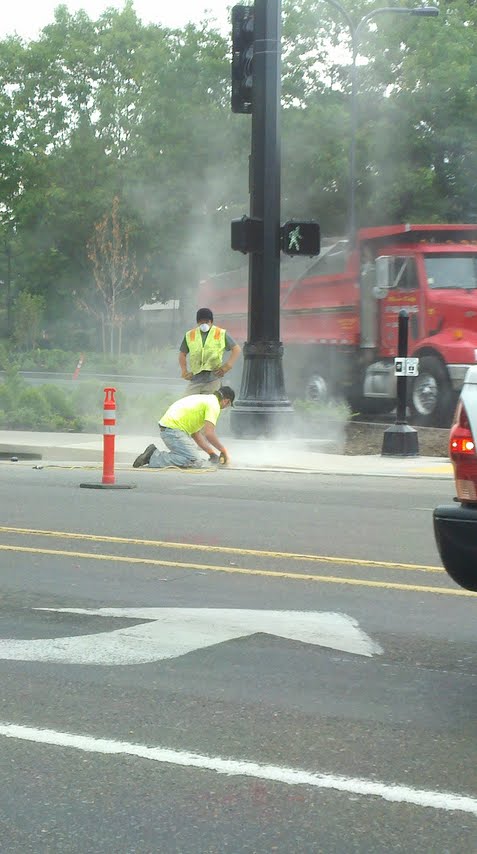Entries tagged with “silica”.
Did you find what you wanted?
Thu 19 May 2016
Posted by admin under Asbestos, Grant, Hazard Communication, hygienist, industrial hygienist, Lead, Leaded Sheetrock, Noise, OSHA, Presentation, Risk, Silica, Training, Uncategorized
Comments Off on Coming soon – Free Video & Training Materials (Health Hazards in Construction)
Exciting news! In just a few months we will be releasing free training materials!
In summary: I applied (and obtained) a grant through OSHA to produce training materials for the four major health hazards in construction. We are titling it, “Focus 4 Health Hazards for Construction”.  (similar to the Focus 4 Susan Harwood training materials available at OSHA)
Indented audience is for younger construction workers in hazard recognition of, 1. silica, 2. noise, 3. asbestos and 4. lead (pb) in construction. A short video (1-4 minutes) for each subject gives an introduction to the hazard. And, to follow up a training power point presentation (and short summary) will also be available to further instruct people in how to control and protect themselves.
On a personal level…it has been exhausting, and I’ve learned a lot!  From obtaining the grant, to hiring a videographer, filming, securing filming sites, and quarterly reports…. exhausting.  But, I’m confident you (and others) will enjoy it. Subscribe (via email) to keep updated. You can also follow me on instagram: “adventuresInIH”. (link coming)

Wed 27 Nov 2013
Posted by admin under Asbestos, Building Survey, Dermal, Drywall, Dust, Exposure, Fall Protection, Gloves, hearing protection, Ladder, Ladders, Lead, Leaded Sheetrock, Management, Noise, occupational hygiene, OSHA, Powder Actuated Tool, Respirators, safety, Silica, Uncategorized
Comments Off on Top 10 Hazards of drywall
I titled this post, “hazards of drywall”, but it encompassing most of the common hazards of plaster, mud, gypsum, wall-hangers, tapers, and acoustic employees.
-
Corrosive drywall.
I have not dealt with this subject on a personal level. However, AIHA has a new guidance document titled, “Assessment and Remediation of Corrosive Drywall: An AIHA Guidance Document“, which is a clarification of an earlier white paper document from 2000, titled, “Corrosive Drywall“. The danger is from a specific type of drywall which was imported from China. After installation it is known to emit sulfide vapors, which corrode copper (electrical wires), and can give off a sulfur smell (HT to JeffH in Ohio).
-
Asbestos in mud/plaster.
Be aware, some older buildings (pre 1980s) may have asbestos in the mud compound or plaster (not as common). This will be a concern if you are performing demo on these walls. Info here.
-
Silica (dust) in joint (mud) compound.
Some types of silica I have found to have silica. This can be an issue when sanding. AND, if you install drywall like me…you do a lot of sanding. More information from an earlier post can be found here. NIOSH has some suggestions too.
- Leaded sheetrock. If you are installing (or demo) leaded sheetrock, you NEED to protect yourself. Airborne levels of lead can approach the exposure limits, even during installation. More info here.
- Lead in paint. If you’re tying into existing plaster/drywall and there’s paint, you need to know if there’s lead in it. Sanding on the paint is a good way to be exposed. More info here.
- Ergonomics. Hanging the wallboard takes a toll on your body after 20 years (or less). Not to mention sanding. Washington OSHA (L&I) has a good demo.
- Noise. Cutting steel studs, powder actuated tools (there’s lead exposure too, you know).
- Skin hazards. Cutting, but also dermatitis from prolonged exposure to dust.
- Eye hazards. Dust, carpentry, etc. Working overhead is an easy way to get falling items in your eyes.
- Falls. Last on my list, but certainly not the least. Scaffolding, working from ladders, and using stilts, to name a few.
Tue 19 Nov 2013
Posted by admin under Dust, Exposure, Federal OSHA, OSHA, PEL (Perm Exp Limit), Silica, Uncategorized
Comments Off on Silica rule delayed
For better, or worse, the silica rule has been delayed, again. This delay is for an extension of the public comment period, which goes until December 12, 2013. Public hearings are set to begin on March 4, 2014.
Find OSHA here, with links to my previous post. A NPR story from February, 2013.
My views on this rule haven’t changed much: It’s still a mixed-bag. There are still overexposures to silica (see my pictures from the last 3 weeks). However, will the new rule change the behavior?
- Overexposures are still happening
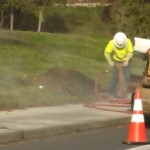
- Silica deaths have decreased over the past (without the new rule)
- Will the small employers (the ones who typically offend the most) comply? Or just wait to be cited?
But, my overwhelming thought is this:
- Any new rule will generate “noise” for the subject of silica. And, that’s a good-thing.
- This will drive:
- compliance
- changes
- innovation
- discussions
- awareness
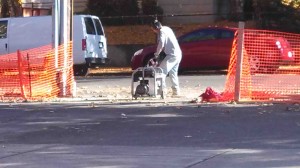
Wed 14 Aug 2013
I was visiting a friend and in their neighborhood all of the curbs were cut for driveways (they were not poured for the cutouts). 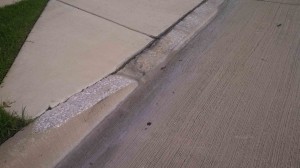
This might have saved some time for the carpenters forming & pouring the concrete. But it created additional work for the concrete cutters and the finishing of the driveways.
This lack of pre-planning created:
- additional time to cut the curb,
- dust (and silica, for sure),
- the use of additional water (hopefully) to control the dust,
- respirators (& cartridge filters),
- exposure to noise, dust, silica
I don’t know the circumstances why this occurred, but I wonder if the person planning the development thought of the exposures to other human beings?
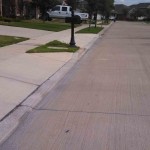
ps. Sorry for my blogging absence. Have been on vacation! (for some of it)
Fri 1 Mar 2013
Posted by admin under Carcinogen, Exposure, Silica
Comments Off on Silica during chipping hammer
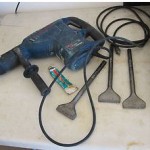 Yes, there can be airborne silica in the concrete when you are chipping up motar & tiles from a concrete base. This week a friend told me about his neighbor. He is a self-employed tile setter. He has worked in the industry for 20+ years. They just discovered he has cancer and will have the upper portion of his lungs removed.
Yes, there can be airborne silica in the concrete when you are chipping up motar & tiles from a concrete base. This week a friend told me about his neighbor. He is a self-employed tile setter. He has worked in the industry for 20+ years. They just discovered he has cancer and will have the upper portion of his lungs removed.
Go here for more information. NPR article on silica rule delay.
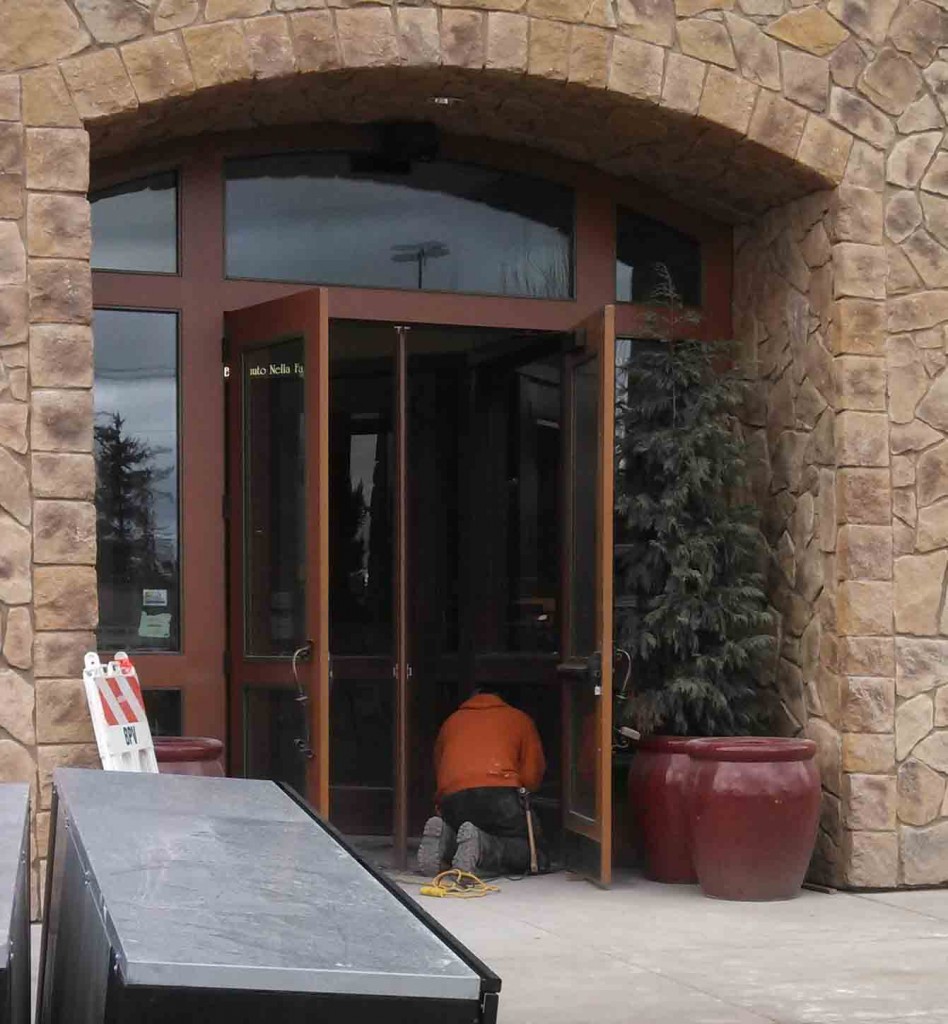
Wed 12 Dec 2012
Posted by admin under Air Monitoring, Behavior Based, Concrete, Dust, Engineering Controls, Exposure, Hazard Communication, HEPA, Management, Personal Protective Equip (PPE), Respirators, Safety Policies, Safety Programs, Silica, Training
Comments Off on Pre task planning – for silica
Controlling most of these types of exposures is really simple. If you know the job- and you know it will generate airborne silica = Pre Task Plan!
I wish Superintendents would enforce their project managers, or project engineers, to make a pre-task plan for every concrete/silica producing task. Then, (please don’t stop yet), review the plan once the project starts!
Below are two examples with different outcomes: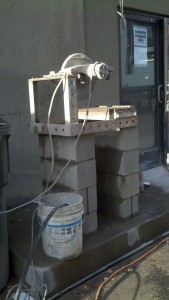
1. Cutting concrete block.
The pretask plan called for a garden hose with attachment(s) to wet the cutting area. Everything was perfect until the water was shut off. But, they improvised and found an electric water pump with bucket and recycled the water. It was a great outcome. What if the power went out? They could have used a Hudson sprayer.
2. Grinding plaster off a brick wall.
They built an enclosure and containment. They had a negative air machine with HEPA filters. They had a vacuum with HEPA filters, tyvek, 1/2 face respirator, eye protection, etc. But, as they worked the vacuum couldn’t keep up with the amount of dust generated by the 7 inch Bosch grinder. It was really dusty. They worked like this for days. No one onsite saw them because they were in containment. Unfortunately the project is almost over and it could have been better. A simple shroud to the grinder, like this one (no endorcement) might have controlled the dust & silica. Sure, it might have been troublesome to find the exact one, and get a vacuum attachment, and have the extra weight, and ….
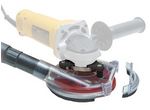
So, let’s talk to people about silica, talk about solutions, and then check to see if they’re effective.
Wed 17 Oct 2012
Posted by admin under Admin Controls, Air Monitoring, Concrete, confined space, Engineering Controls, Exposure, Federal OSHA, fit testing, Hazard Communication, Hearing Conservation, hearing protection, Management, Noise, OSHA, Permit Required, Personal Protective Equip (PPE), Respirators, Safety Policies, Safety Programs, Silica, Training, Uncategorized, ventilation
Comments Off on Ready Mix Drum Chipping
If you operate a ready-mix plant and have concrete trucks, you are aware of this process. Once a year (hopefully, only once) a person must climb into the drum of the ready-mix truck and chip off excess concrete. What happen during regular use, is that some concrete hardens, which usually sets-up over and around the blades. Access into the drum is by either the 3×4 hole in the side, or down the chute.
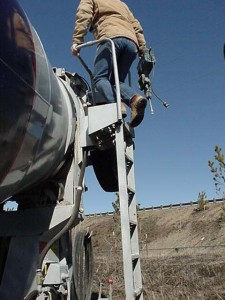
Yes, it is a confined space (def’n: 1. large enough to enter, 2. not designed for occupancy, and 3. limited entry/egress).
Here are a list of the possible hazards:
- silica dust (from chipping concrete)
- noise exposure
- hazardous atmosphere (curing concrete uses up oxygen, which we DO need BTW)
- slipping hazard (drum is round inside)
- heat stress (if you’re trying to do this activity in the summer)
- eye hazard (chipping)
- electrical hazard (if you’re using water & have an electric hammer)
- lock out / tag out (if the truck drives away, or if the barrel starts turning)
There are many resources available (see below). Some things to keep in mind; ventilation (fans, etc) to control the airborne silica dust are usually not effective (too much dust versus exhaust). Water controls are best, but you must limit the amount of water and the direction of the sprayer. I suggest looking at what others have done.
Keep in mind, if you perform this activity you will need (as a company):
- respiratory program (medical, fit test, written plan)
- confined space program (multi gas meter, written program, attendant?)
- lock out /tag out policy or procedures
- training (for each of the above, and for this specific activity)
At this point I know what my contractor-friends are thinking…I will subcontract this out!  ha. If you do, please make sure your sub is doing it right.
Resources:
Georgia Tech – good presentation & guidance
Georgia Tech/OSHA – Safe Work Practices (in Spanish too!)
Teamsters H&S hazards & controls
Illinois DCEO – Consultation on ready mix cleaning
Mon 17 Sep 2012
Posted by admin under Air Monitoring, Asphalt, Silica
Comments Off on Silica in asphalt

For people who work with asphalt everyday, this may be a obvious statement: Silica is in asphalt.
There are two areas where this might be of concern: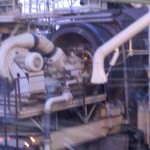
- During the mixing of the asphalt there is usually some ratio of rocks that are added to the product. The size of these rocks is where safety personnel should have concerns. If they are adding the smallest fraction of rock to the mix, you may have airborne exposures to silica. This size of rock is called P200 (or, using a 200 sieve screen to get anything less than 200 parts per inch). Usually this is seen during the transfer of rock from the loader or from the belt conveyor.
- The other method of exposure to silica in asphalt is if you cut it. Rocks may contain silica. When asphalt is cut, you incidentally cut through various rocks (contained within the asphalt). Silica (and dust) is released during the cutting. Please use water when you are cutting asphalt. Direct the water at the blade.

Mon 9 Jul 2012
Posted by admin under Asbestos, Lead, Management, Silica, Training
Comments Off on Construction Training Idea – add Silica
I was asked to perform asbestos training…and, “…maybe talk a little on lead”. However, I knew the employees needed to hear something totally different.
The firm requesting the training was a large excavation company that does a lot of road work. The training was at their bi monthly company wide meeting . I was given one hour.
So, my idea: Give them a quick overview of asbestos and lead, and then talk to them about silica. I called the training, “IH Health Topics in Construction”. And, as suspected, the questions that were posed all dealt with either: 1. “in my home I have…” or 2. silica and how to protect themselves.
I have made it my personal aim to talk about silica to as many employees as I can. I throw it into any training (even if I have just 5 minutes). Chances are, these guys WILL have overexposure to silica. Â The owner did not mind since I told him we were going to talk about a few different kinds of health issues in construction.
My suggestion: see if you can work Silica into your conversations and trainings.
Tags: construction, cristobalite, excavation, IH, quartz, safety, silica, silicosis, train, trained, training
Tue 26 Jun 2012
‘Tis the season for silica (here, and here too).
I had four observations about this picture,
- paper dust masks are totally inadequate for this task, and
- why isn’t there any engineering controls (water?, vacuum?), and
- why is the observer standing in the dust plume?, and
- what does the employees do with their clothes after work?
Please be safe out there.
